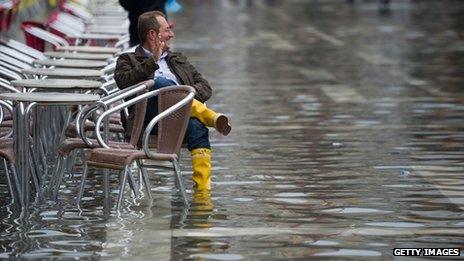Venice flood barriers pass first test
- Published
Watch: The mobile flood barriers emerge from the water
Barriers designed to protect the Italian city of Venice from flooding during high tides have been successfully tested for the first time.
Four large floodgates rose out of the water creating a temporary sea barrier.
Once completed, 78 mobile flood barriers will be raised from the seabed to shut off the lagoon in the event of rising sea levels and winter storms.
The city suffers flooding on a yearly basis. In 1966, 80% of the city was flooded by high tides.
Funding delays
Applause broke out among the VIPs invited to witness the first public test of the project, says the BBC's David Willey in Rome.
Construction on the barriers began 10 years ago but has been hampered by delays in funding due to Italy's economic crisis.
The Moses project has already cost more than $7bn (£5bn) and is not expected to be completed for another two years.
Once finished, the floodgates will extend more than a mile, blocking the three inlets to the lagoon.
A government minister has promised funds to complete the scheme on time in 2016.
But the head of the construction consortium said they would need $800m immediately, otherwise the jobs of some 4,000 construction workers would be at risk.
Some Venetians argue the project is a waste of money and there is no guarantee it will work, our correspondent says.
In 1966, some 5,000 people were left homeless when flood levels in the city reached 1.94m (6ft) causing immense damage.
Earlier this week, Venice saw its first high tide of the season, known as "acqua alta".

Venice's high tides commonly affect the city during the autumn and winter
- Published13 November 2012